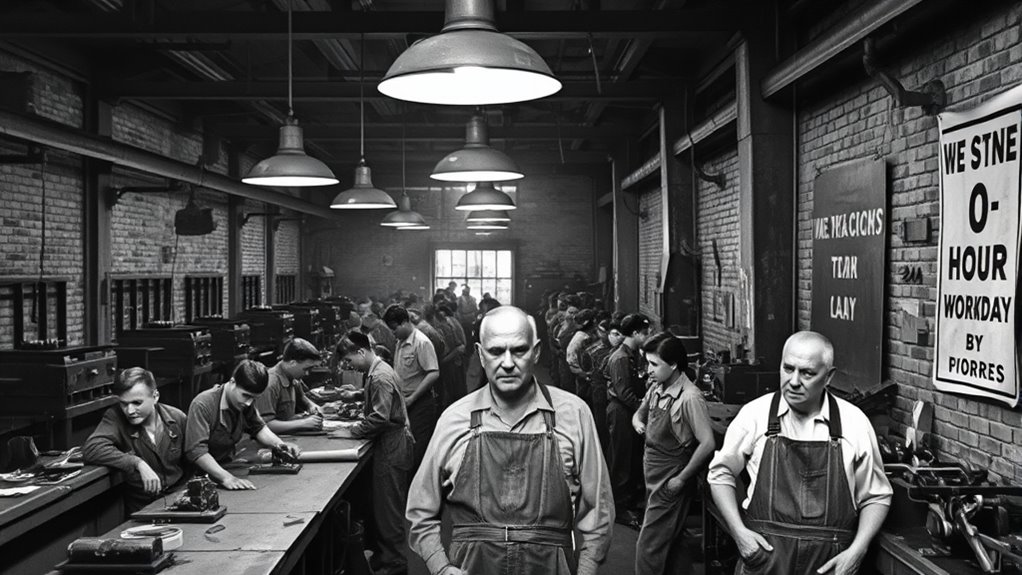The eight-hour workday started in the 19th century as workers and unions fought for fair hours, with key figures like Samuel Gompers leading the charge. It spread internationally, symbolizing workers’ rights and labor reforms. Critics argue shorter hours hurt productivity, while others point to benefits like better focus and well-being. To understand how this debate evolved and what lies ahead, explore the history and modern challenges surrounding this iconic labor standard.
Key Takeaways
- The eight-hour workday originated in the 19th century as a labor movement effort to improve worker conditions and promote work-life balance.
- Key figures like Samuel Gompers and events such as the Haymarket Affair helped galvanize global support for shorter work hours.
- Critics argue that rigid adherence to eight hours can hinder productivity, flexibility, and adaptation to modern industry needs.
- Modern challenges include worker fatigue, burnout, and debates over fair labor practices and workplace well-being.
- Lessons from history emphasize the importance of balanced reforms that consider economic growth, worker health, and social equity.
Origins of the Eight-Hour Workday Movement
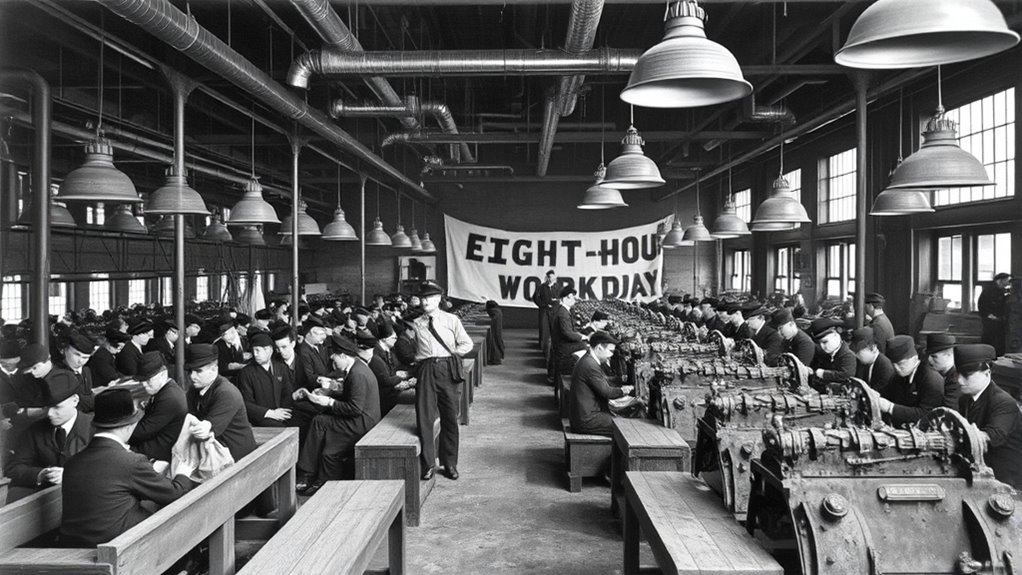
The movement for an eight-hour workday began in the early 19th century as workers sought to improve their conditions and reclaim time for rest and leisure. Labor unions played a critical role, organizing strikes and protests to demand better working conditions. At that time, many workers endured long hours, often 12 or more per day, with little regard for safety or health. By forming unions, workers gained collective power to push for reforms. Their efforts highlighted the need for a standard workday that balanced labor with personal life. The push for an eight-hour workday became a symbol of workers’ rights and a essential step toward improving labor conditions across industries.
Key Figures and Milestones in Labor Rights
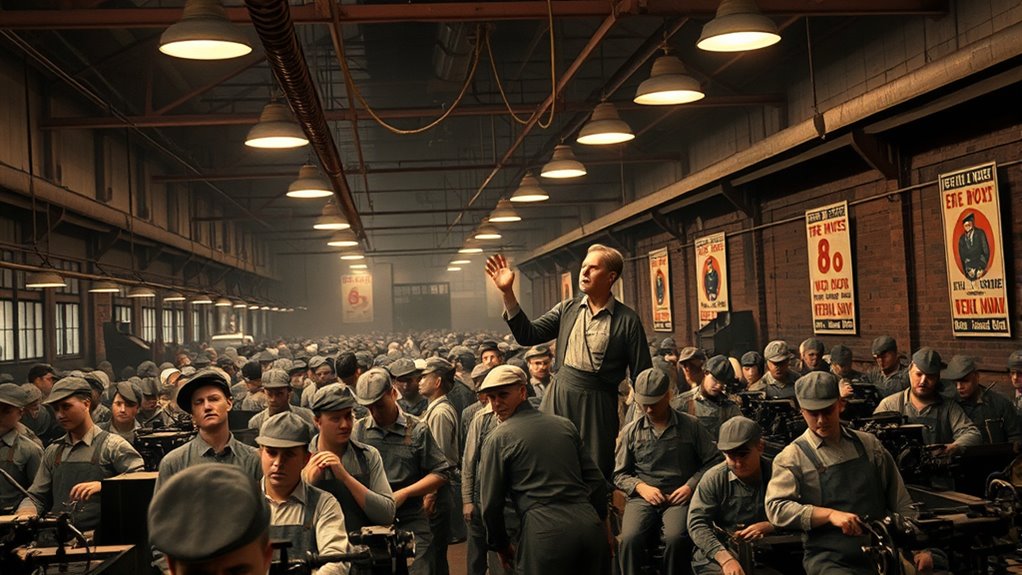
Throughout the fight for an eight-hour workday, several key figures and milestones shaped the movement’s success. Leaders of labor unions played vital roles by organizing strikes and advocating for workers’ rights, making their voices heard through political activism. Samuel Gompers, as a prominent union leader, championed improved working conditions and fair hours. The Haymarket Affair of 1886 marked a pivotal milestone, highlighting the power of collective action and sparking international support. The establishment of organizations like the American Federation of Labor helped coordinate efforts and push for legislative change. These figures and events galvanized workers’ movements, transforming demands for shorter hours into a broader fight for labor rights. Their influence laid the foundation for the legal protections and labor standards we recognize today.
The Adoption of the Eight-Hour Day Worldwide
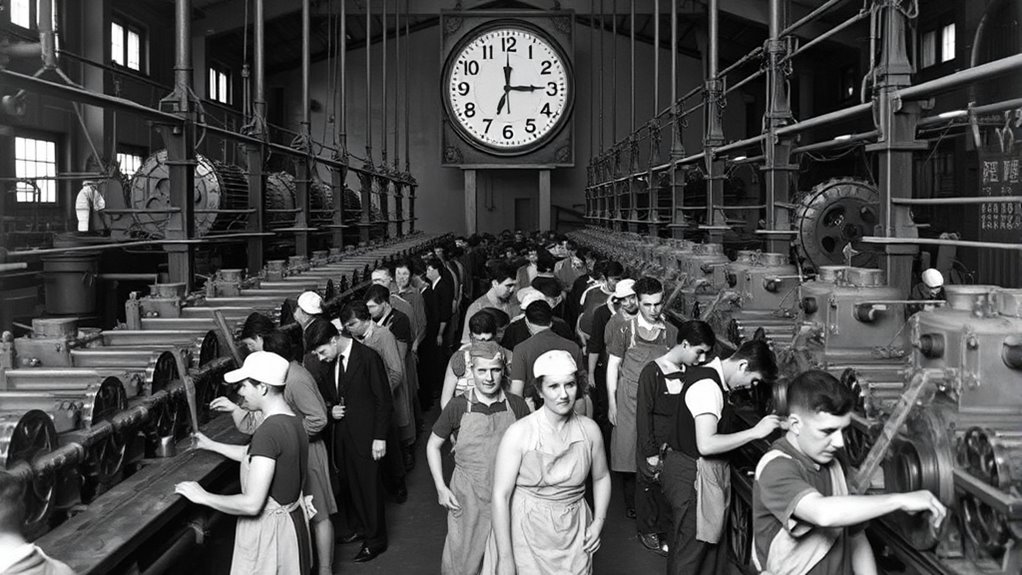
As the movement for an eight-hour workday gained momentum in the United States, other countries soon recognized its significance and began adopting similar standards. Labor unions played a pivotal role in advocating for this change, pushing governments and companies to improve work conditions. Countries like Australia, the United Kingdom, and Germany started implementing shorter work hours, inspired by the American labor movement. The shift aimed to promote a healthier work-life balance, allowing workers more time for family, leisure, and personal development. International pressure and solidarity among workers helped spread the eight-hour standard across continents. Ultimately, this global adoption marked a significant step toward recognizing workers’ rights and improving quality of life worldwide. Additionally, the adoption of Crochet Styles for Locs was an example of how cultural expressions can evolve alongside labor reforms, reflecting broader social changes.
Economic Arguments Supporting the Standard Workday
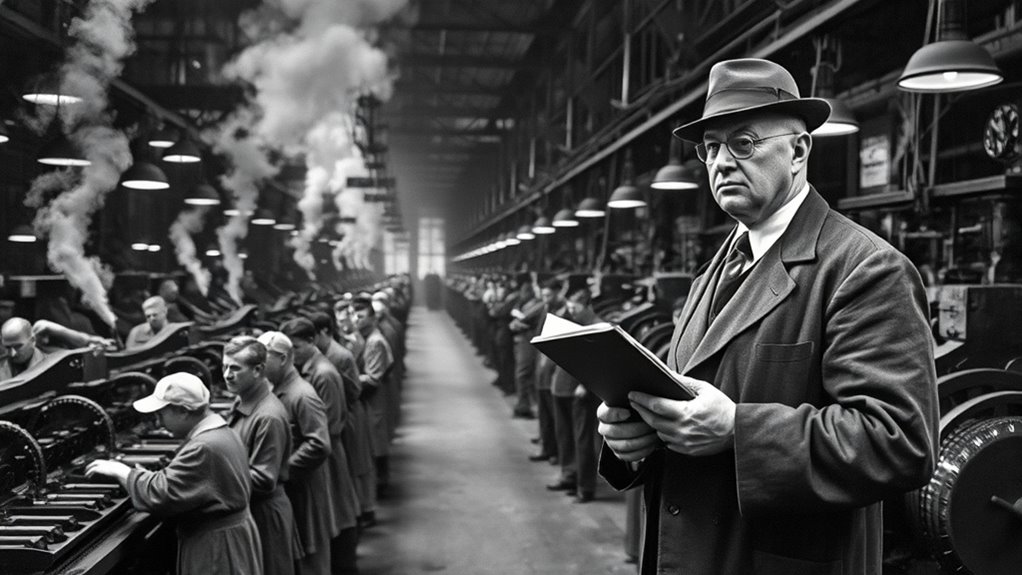
Implementing an eight-hour workday can boost economic productivity by encouraging workers to be more focused and efficient during their hours on the job. Shorter hours lead to productivity gains, as employees are less prone to fatigue and burnout. This enhances economic efficiency, maximizing output with fewer wasted efforts. Consider the following:
| Longer Hours | Focus & Efficiency | Output Growth |
|---|---|---|
| Fatigue sets in | Concentration drops | Errors increase |
| Burnout occurs | Motivation declines | Quality suffers |
| Extended shifts | Reduced alertness | Productivity dips |
| More hours, less focus | Efficiency wanes | Profit decreases |
| Balanced hours | Sharp focus | Higher productivity |
Additionally, work hours significantly influence employee well-being, which in turn impacts overall economic performance.
Criticisms and Challenges to the Eight-Hour Model
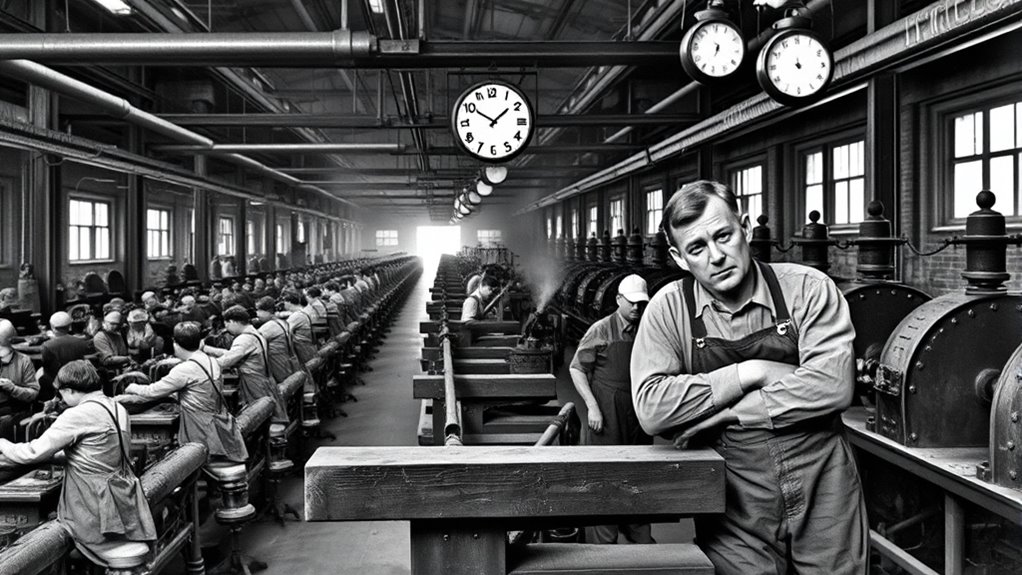
While shorter workdays can boost productivity, they also face significant criticisms and practical challenges. One major issue is adapting overtime regulations, which often favor longer hours or make it hard to limit work time without affecting wages. Additionally, workplace automation complicates the eight-hour model, as machines increase output beyond traditional limits, pressuring companies to extend hours or cut costs. Critics argue that rigid adherence to an eight-hour day may hinder flexibility and innovation. There’s also concern that a strict schedule doesn’t account for individual productivity variations or the needs of different industries. These challenges highlight that balancing worker well-being with economic efficiency remains complex, especially as technological and regulatory landscapes evolve. Incorporating natural materials and creating a comfortable environment may help address some of these issues by fostering better work-life balance and well-being.
The Impact of the Eight-Hour Workday on Modern Work Culture
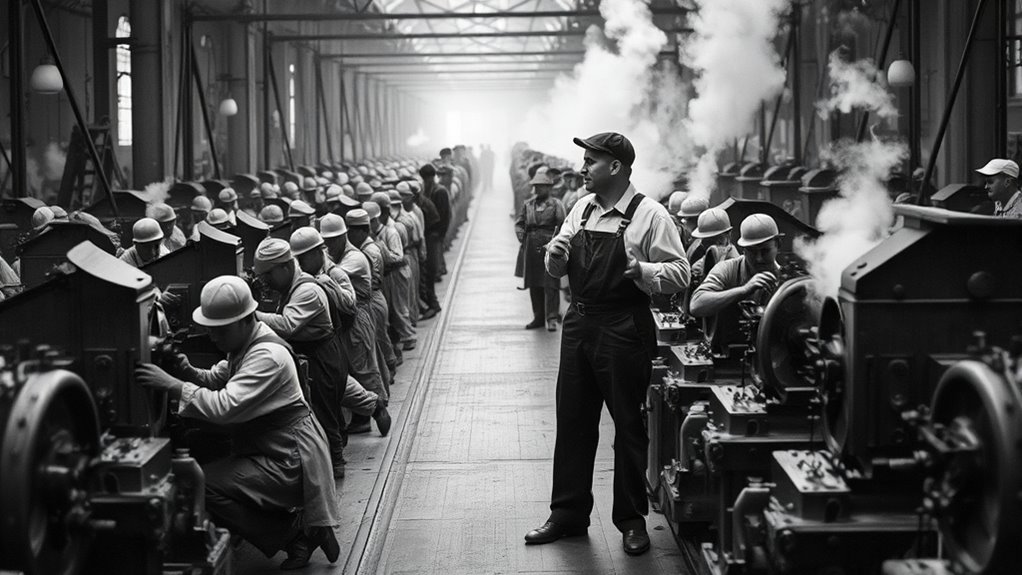
The eight-hour workday has profoundly shaped modern work culture by establishing a routine that balances productivity with personal life. Today, this structure influences how you approach remote work, helping maintain boundaries between professional and personal time. It also underpins the gig economy, where flexible hours coexist with traditional schedules. The eight-hour model encourages organizations to optimize efficiency while respecting workers’ well-being. As technology advances, this framework adapts to new work environments, fostering a balance that supports mental health and work-life harmony. You benefit from clearer expectations and a more predictable routine, whether working from home or juggling freelance gigs. Incorporating calming decor and natural elements can further enhance your workspace, promoting a peaceful environment conducive to productivity. Overall, the eight-hour workday continues to impact how you organize your workday, promoting a sustainable approach amidst evolving workplace dynamics.
Ongoing Debates and Future Perspectives
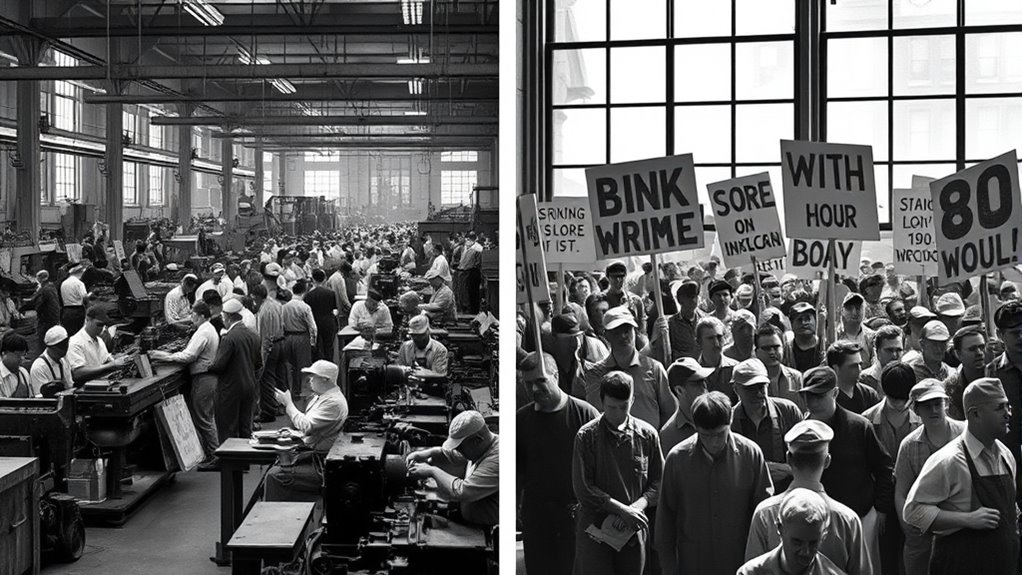
As discussions about the eight-hour workday continue, debates focus on whether this traditional model still serves today’s evolving workforce. You might question if a rigid schedule suits remote work or the gig economy’s flexible nature. The future could see more experiments with work hours, balancing productivity and well-being. Critics argue that fixed hours may limit creativity and autonomy, especially as remote work grows. Meanwhile, proponents believe a structured schedule maintains discipline and efficiency. Key points to contemplate include:
- The rise of flexible schedules for remote workers
- How gig economy jobs challenge fixed work hours
- Potential for new models that blend work and leisure
- The increasing use of fraud detection tools to secure online transactions and protect businesses.
These debates reflect a broader shift toward personalized work arrangements, aiming to adapt the eight-hour standard to modern needs.
Lessons From History and the Path Forward
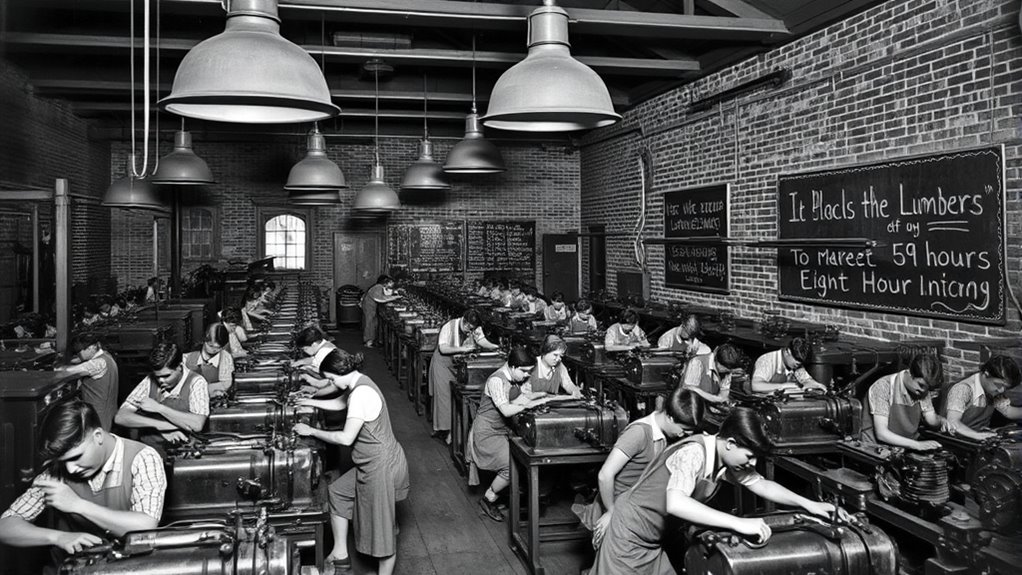
History shows that workers’ struggles for fair hours keep resurfacing, reminding us of ongoing challenges. You need to contemplate how balancing work and well-being has shaped policies over time. These lessons can guide us in creating a fairer future for everyone. Recognizing the importance of vetted product reviews helps inform decisions that support fair labor practices and workplace satisfaction.
Historical Struggles Resurface
Past struggles for the eight-hour workday are resurfacing as new debates about workers’ rights and fair labor practices emerge. Today, you witness a resurgence of labor activism highlighting issues like worker fatigue and job security. These efforts remind us that history’s lessons aren’t forgotten. You might see protests demanding better enforcement of fair labor laws or campaigns advocating for safer working conditions. Recognizing these patterns helps us understand that the fight for reasonable hours isn’t over. Increased worker activism driven by exhaustion and burnout, along with projector technology, underscores the importance of addressing workplace fatigue. Calls for stricter regulations to prevent worker fatigue and renewed debates about fair compensation and work-life balance continue to shape the modern labor landscape.
Balancing Work and Well-being
Learning from history shows that achieving a healthy balance between work and well-being requires intentional effort and policy changes. Prioritizing work life balance helps protect your mental health and prevents burnout. Throughout history, societies that pushed for longer hours often overlooked the toll on individuals, leading to stress and decreased productivity. Today, you can advocate for practices that promote flexibility, such as reasonable working hours, remote work options, and mental health support. Recognizing the importance of mental health in maintaining overall well-being is vital for sustainable work environments. By learning from past struggles, you can push for reforms that value your health as much as your work output. Implementing employee wellness programs can significantly contribute to this goal. Striking this balance isn’t just beneficial for individuals—it benefits organizations and society as a whole.
Shaping Future Policies
To shape effective future policies, you must understand the lessons that history offers about successful reforms and common pitfalls. Past efforts to implement the eight-hour workday show that stakeholder buy-in, adaptable regulations, and proactive communication are critical. As technological automation advances, policies should prioritize worker protections without hindering innovation. Remote work’s rise highlights the need for flexible labor standards that address work-life balance and productivity. Anticipating resistance and building consensus can prevent setbacks. Embracing lessons from history helps you craft policies that balance economic growth with workers’ well-being. Considering modern farmhouses and their design principles also provides insights into creating adaptable and resilient workspaces. By learning from past successes and failures, you can develop sustainable, inclusive reforms for a changing work landscape. This approach ensures future policies are resilient, forward-thinking, and equitable.
Frequently Asked Questions
How Did Cultural Differences Influence the Implementation of the Eight-Hour Workday Globally?
You see, cultural differences shape how countries adapt the eight-hour workday, affecting work norms globally. Some cultures prioritize work-life balance, embracing shorter hours, while others value long hours for productivity. Cultural adaptation influences policies and how workers perceive their routines. You might notice that in some regions, traditional work customs resist change, while in others, progressive shifts towards the eight-hour standard reflect evolving cultural attitudes toward labor and daily life.
What Role Did Government Policies Play in Enforcing or Resisting the Eight-Hour Workday?
You see, government policies, through labor laws and intervention, considerably shaped the eight-hour workday. When authorities enforce these laws, they set standards that limit working hours, protecting workers’ rights. Conversely, resistance from governments can delay or weaken implementation. Your understanding highlights how government intervention either promotes fair labor practices or faces opposition, influencing the pace and extent of adopting the eight-hour workday worldwide.
How Have Technological Advancements Affected the Relevance of the Eight-Hour Workday Today?
Imagine your workday stretching endlessly, like an infinite highway. Today, tech advancements like automation challenges traditional hours, making the 8-hour day seem almost obsolete. Remote work blurs lines between work and life, turning your home into the workplace. You might work anytime, anywhere, questioning if strict hours still matter. These innovations reshape how we see work, making the old 8-hour rule feel like a relic from the past.
Are There Industries Where the Eight-Hour Workday Is Less Effective or Applicable?
You’ll find that in some industries, the eight-hour workday faces practical limitations due to industry-specific challenges. For example, healthcare and emergency services often require flexible or longer shifts to guarantee continuous care, making strict adherence difficult. Similarly, creative or tech sectors may benefit from adaptable schedules to boost productivity. These practical limitations highlight that a one-size-fits-all approach isn’t always effective across different fields.
What Alternative Work Schedules Are Being Proposed as Successors to the Eight-Hour Model?
Think of work schedules as a shifting tide, constantly evolving. You might explore flexible scheduling, allowing you to tailor your hours to fit your life better, or a four-day workweek that stretches your free time. These alternatives aim to boost productivity and well-being, giving you more control over your day. As the waves change, so do the options, creating a more adaptable and balanced approach to work.
Conclusion
Imagine the eight-hour workday as a sturdy bridge you’ve helped build, spanning the turbulent river of endless labor. Its stones—history, struggle, and reform—support your journey toward balance. As you cross, remember that critics may throw stones or try to dismantle it, but your footsteps keep the bridge strong. Embrace the lessons, and together, you can chart a future where work and life walk side by side, safely on this enduring bridge.
